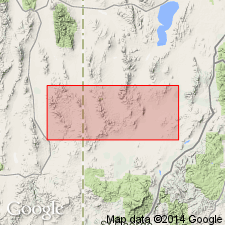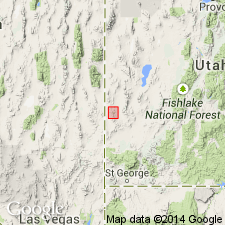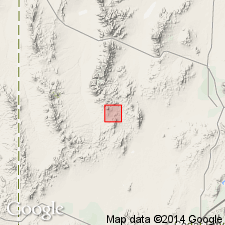
- Usage in publication:
-
- Greens Canyon Tuff Member
- Modifications:
-
- First used
- AAPG geologic province:
-
- Great Basin province
Summary:
Greens Canyon Tuff Member of the Ryan Spring Formation of the Needles Range Group is used in the Mountain Home Mountains, Beaver Co, UT and the White Rock Mountains, Lincoln Co, NV. Interfingers with the andesite member of the Ryan Spring; overlies the Wah Wah Springs Formation; underlies the Mackleprang Tuff Member of the Ryan Spring. Age is Oligocene based on stratigraphic position.
Source: GNU records (USGS DDS-6; Menlo GNULEX).

- Usage in publication:
-
- Greens Canyon Tuff Member*
- Modifications:
-
- Named
- Dominant lithology:
-
- Tuff
- AAPG geologic province:
-
- Great Basin province
Summary:
Named as one of the oldest of four members of Ryan Spring Formation of Needles Range Group for Greens Canyon in Miners Cabin Wash quad, Beaver Co, UT, Great Basin province. Type section is in sec 6, T29S, R18W, Beaver Co. Is the lower simple cooling unit of Ryan Spring. Upper part composed of crystal-poor, lithic-rich rhyolite ash-flow tuff. Overlies breccias and tuffs of intracaldera member of Wah Wah Springs Formation and underlies Mackleprang Tuff Member of Ryan Spring at the type. Was derived from Indian Peak caldera. Is confined to the northern margin of the caldera; areal extent shown on map. Extends over an area of 400 sq km in southwest UT and adjoining east-central NV (map); has a volume of 150 cubic km. Assigned to the Oligocene. Stratigraphic chart.
Source: GNU records (USGS DDS-6; Denver GNULEX).

- Usage in publication:
-
- Greens Canyon Tuff Member*
- Modifications:
-
- Named
- Dominant lithology:
-
- Tuff
- AAPG geologic province:
-
- Great Basin province
Summary:
Greens Canyon Tuff Member (lower cooling unit) of the Ryan Spring Formation of the Needles Range Group is named for exposures in Greens Canyon, Miners Cabin Wash 7.5' quad, Beaver Co, UT. Type section is in sec.6, T29S R18W. Consists of crystal-poor, lithic-rich, rhyolite ash-flow tuff. Lithic fragments are of volcanic, carbonate, and quartzite composition. Overlies breccias and tuffs of intracaldera member of the Wah Wah Springs Formation; overlain by the Mackleprang Tuff Member (new) of the Ryan Spring. Covers over 400 sq km and has a volume of 150 cu km. Age is Oligocene based on stratigraphic position.
Source: GNU records (USGS DDS-6; Menlo GNULEX).
For more information, please contact Nancy Stamm, Geologic Names Committee Secretary.
Asterisk (*) indicates published by U.S. Geological Survey authors.
"No current usage" (†) implies that a name has been abandoned or has fallen into disuse. Former usage and, if known, replacement name given in parentheses ( ).
Slash (/) indicates name conflicts with nomenclatural guidelines (CSN, 1933; ACSN, 1961, 1970; NACSN, 1983, 2005, 2021). May be explained within brackets ([ ]).

